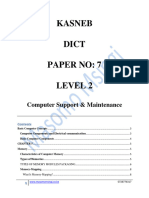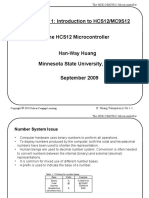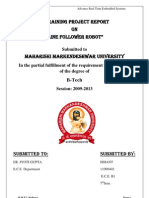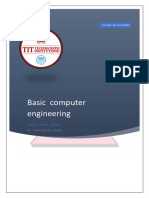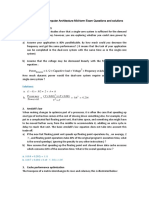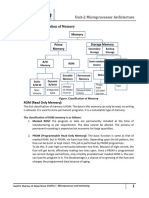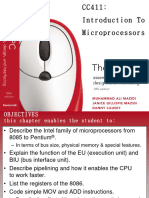Memories of An Arduino
Uploaded by
Taha ShariatiMemories of An Arduino
Uploaded by
Taha ShariatiMemories of an Arduino
Created by Bill Earl
https://learn.adafruit.com/memories-of-an-arduino
Last updated on 2023-08-29 02:22:13 PM EDT
©Adafruit Industries Page 1 of 25
Table of Contents
You know you have a memory problem when... 5
• "The memory is the first thing to go."
Memory Architectures 6
• Harvard vs Princeton
• Which is better?
• Modern Hybrids
• Microcontrollers
• A completely different Scale
Arduino Memories 8
• Flash Memory
• SRAM
• EEPROM
Arduino Memory Comparision 10
Measuring Memory Usage 10
• Flash
• EEPROM
• SRAM
Large Memory Consumers 12
• SD Cards
• Pixels
• RGB Matrix Displays
• Monochrome OLED Displays
• ST7565 LCD Displays
• e-Ink Displays
Solving Memory Problems 18
• "Running Light Without Overbyte"
Optimizing Program Memory 19
• Remove Dead Code
• Consolidate Repeated Code
• Eliminate the Bootloader
Optimizing SRAM 20
• Remove Unused Variables
• F() Those Strings!
• (Park the char* in Harvard PROGMEM)
• Reserve() your strings
• Move constant data to PROGMEM.
• Reduce Buffer Sizes
• Reduce Oversized Variables
• Think Globally. Allocate Locally.
• Global & Static Variables
• Dynamic Allocations
• Local Variables
• The Takeaway?
©Adafruit Industries Page 2 of 25
Using EEPROM 24
• uint8_t read(int)
• void write(int, uint8_t)
©Adafruit Industries Page 3 of 25
©Adafruit Industries Page 4 of 25
You know you have a memory problem
when...
"The memory is the first thing to go."
(I don't remember who told me that)
The most obvious sign of a memory problem is when the compiler tells you that your
sketch is too big.
But many memory problems show much more subtle symptoms. Your program may
load, but not run. It may crash hard, or just start acting funky.
If your program compiles and loads successfully, but any of the following statements
are true, there is a good chance that you have a memory problem.
"My program worked fine until I" (choose one)
◦ "Included one more library"
◦ "Added some more LED pixels"
◦ "Opened a file on the SD card"
◦ "Initialized a graphical display"
◦ "Merged in another sketch"
◦ "Added a new function"
If you think you might have a memory problem, you can skip right to the "Solving
Memory Problems" page. But you should first take a look through the next few pages
to better understand Arduino memory and how it works.
©Adafruit Industries Page 5 of 25
Memory Architectures
Harvard vs Princeton
In the early days of electronic computing, two different processor/memory
architectures emerged:
The Von Neumann () (a.k.a. ()Princeton ()) ()architecture () developed for the
ENIAC ()uses the same memory and data paths for both program and data storage.
The Harvard architecture () characterized by the Harvard Mark 1 () used physically
separate memory and data paths for program and memory.
©Adafruit Industries Page 6 of 25
Which is better?
Each architecture has its advantages: All else being equal, the Harvard model has the
edge in performance. The Von Neumann model is more flexible.
Modern Hybrids
These days, most general purpose computers (PC's Mac's etc.) are hybrid designs that
give you the best of both architectures. Deep within the CPU they operate on the
Harvard model using separate caches for instructions and data to maximize
performance. But the instruction and data caches are both loaded automatically from
a common memory space. From a programming perspective, these computers appear
to be pure Von Neumann machines with many gigabytes of virtual storage.
Microcontrollers
Microcontrollers such as the ones that power the Arduinos are designed for
embedded applications. Unlike general purpose computers, an embedded processor
typically has a well defined task that it must perform reliably and efficiently - and at
minimal cost, Microcontroller designs tend to be rather spartan. They forego the
luxuries of multi-layer caching and disk-based virtual memory systems and stick to
what is essential to the task.
The Harvard model turns out to be a good match for embedded applications and the
Atmega 328 used in the Arduino UNO use a relatively pure Harvard architecture.
Programs are stored in Flash memory and data is stored in SRAM.
For the most part, the compiler and run-time systems take care of managing these for
©Adafruit Industries Page 7 of 25
you, but when things start getting tight, it helps to be aware of how things work under
the hood. And things start getting tight much quicker on these tiny machines!
A completely different Scale
The biggest difference between these microcontrollers and your general purpose
computer is the sheer amount of memory available. The Arduino UNO has only 32K
bytes of Flash memory and 2K bytes of SRAM. That is more than 100,000 times LESS
physical memory than a low-end PC! And that's not even counting the disk drive!
Working in this minimalist environment, you must use your resources wisely.
Arduino Memories
There are 3 types of memory in an Arduino:
• Flash or Program Memory
• SRAM
• EEPROM
Flash Memory
Flash memory is used to store your program image and any initialized data. You can
execute program code from flash, but you can't modify data in flash memory from your
executing code. To modify the data, it must first be copied into SRAM
Flash memory is the same technology used for thumb-drives and SD cards. It is non-
volatile, so your program will still be there when the system is powered off.
Flash memory has a finite lifetime of about 100,000 write cycles. So if you upload 10
programs a day, every day for the next 27 years, you might wear it out.
SRAM
SRAM or Static Random Access Memory, can be read and written from your executing
program. SRAM memory is used for several purposes by a running program:
• Static Data - This is a block of reserved space in SRAM for all the global and
static variables from your program. For variables with initial values, the runtime
system copies the initial value from Flash when the program starts.
©Adafruit Industries Page 8 of 25
• Heap - The heap is for dynamically allocated data items. The heap grows from
the top of the static data area up as data items are allocated.
• Stack - The stack is for local variables and for maintaining a record of interrupts
and function calls. The stack grows from the top of memory down towards the
heap. Every interrupt, function call and/or local variable allocation causes the
stack to grow. Returning from an interrupt or function call will reclaim all stack
space used by that interrupt or function.
Most memory problems occur when the stack and the heap collide. When this
happens, one or both of these memory areas will be corrupted with unpredictable
results. In some cases it will cause an immediate crash. In others, the effects of the
corruption may not be noticed until much later.
©Adafruit Industries Page 9 of 25
EEPROM
EEPROM is another form of non-volatile memory that can be read or written from your
executing program. It can only be read byte-by-byte, so it can be a little awkward to
use. It is also slower than SRAM and has a finite lifetime of about 100,000 write cycles
(you can read it as many times as you want).
While it can't take the place of precious SRAM, there are times when it can be very
useful!
Arduino Memory Comparision
The following chart shows the amounts of each type of memory for several Arduino
and Arduino compatible boards.
"...that's not got much SRAM in it."
Measuring Memory Usage
One way to diagnose memory problems is to measure how much memory is in use.
Flash
Measuring Flash memory usage is trivial. The compiler does that for you, every time
you compile!
©Adafruit Industries Page 10 of 25
EEPROM
You are 100% in control of EEPROM usage. You have to read and write each byte to a
specific address, so there is no excuse for not knowing exactly which bytes are in use!
// ************************************************
// Write floating point values to EEPROM
// ************************************************
void EEPROM_writeDouble(int address, double value)
{
byte* p = (byte*)(void*)&value;
for (int i = 0; i < sizeof(value); i++)
{
EEPROM.write(address++, *p++);
}
}
// ************************************************
// Read floating point values from EEPROM
// ************************************************
double EEPROM_readDouble(int address)
{
double value = 0.0;
byte* p = (byte*)(void*)&value;
for (int i = 0; i < sizeof(value); i++)
{
*p++ = EEPROM.read(address++);
}
return value;
}
SRAM
SRAM usage is more dynamic and therefore more difficult to measure. The freeMemo
ry() function below is one way to do this. You can add this function definition to your
code, then call it from various places in your code to report the amount of free SRAM.
SRAM utilization is dynamic and will change over time. So It is important to call freeM
emory() at various times and from various places in your sketch to see how it
changes over time.
This code is taken from this small library: https://github.com/mpflaga/Arduino-
MemoryFree () and works on both AVR and ARM (M0) processors.
#ifdef __arm__
// should use uinstd.h to define sbrk but Due causes a conflict
extern "C" char* sbrk(int incr);
#else // __ARM__
extern char *__brkval;
#endif // __arm__
int freeMemory() {
char top;
#ifdef __arm__
return &top - reinterpret_cast<char*>(sbrk(0));
©Adafruit Industries Page 11 of 25
#elif defined(CORE_TEENSY) || (ARDUINO > 103 && ARDUINO != 151)
return &top - __brkval;
#else // __arm__
return __brkval ? &top - __brkval : &top - __malloc_heap_start;
#endif // __arm__
}
What freeMemory() is actually reporting is the space between the heap and the
stack. it does not report any de-allocated memory that is buried in the heap. Buried
heap space is not usable by the stack, and may be fragmented enough that it is not
usable for many heap allocations either. The space between the heap and the stack is
what you really need to monitor if you are trying to avoid stack crashes.
Large Memory Consumers
There are devices and drivers which require large amounts of SRAM to operate. Some
of the largest memory consumers are:
©Adafruit Industries Page 12 of 25
SD Cards
Anything with an SD or Micro-SD interface
requires a 512 byte SRAM buffer to
communicate with the card.
©Adafruit Industries Page 13 of 25
Pixels
Each pixel requires just 3 bytes of SRAM to
store the color. But those bytes start to
add up when you have many meters of
strip or a large array.
On an Uno, you might be able to drive as
many as 500 pixels - assuming you don't
use much SRAM for anything else.
©Adafruit Industries Page 14 of 25
RGB Matrix Displays
Like the pixels, these matrix displays
require several bytes of SRAM per pixel.
The 32x32 model requires about 1600
bytes of SRAM. The 16x32 needs around
800 bytes.
©Adafruit Industries Page 15 of 25
Monochrome OLED Displays
These only require 1 byte for every 8
pixels, but due to their high resolution,
there are still a lot of pixels!
The 128x64 version requires 1K of SRAM
The 128x32 uses 512 bytes.
©Adafruit Industries Page 16 of 25
ST7565 LCD Displays
Like the monochrome OLEDs, they only
need 1 byte for every 8 pixels, but they
have a lot of pixels, so they require a 1K
buffer.
©Adafruit Industries Page 17 of 25
e-Ink Displays
These high-resolution monochrome
displays support some basic drawing
modes that do not require in-processor
buffering. But to enjoy the full capabilities
of the Adafruit GFX library, a SRAM buffer
is necessary.
The 2.0" version of this display requires 3K
of SRAM, so GFX is only usable with a
Mega.
Solving Memory Problems
"Running Light Without Overbyte"
Motto of the original "Dr. Dobb's Journal of Computer Calisthenics and
Orthodontia"
Memory is a finite resource on these tiny processors and some applications are just
plain too big for an Arduino. But most code has some room for optimization. So if your
program is just a little overweight, with a little diet and exercise, you can probably
shed enough bytes to make it fit into that Uno again.
©Adafruit Industries Page 18 of 25
Optimizing Program Memory
When you compile your sketch, the IDE will tell you how big the program image is. If
you have reached or exceeded the space available, some of these optimizations may
help get you back under the limit.
This is not meant to be a definitive treatise on how to optimize your code - there are
libraries full of books on the subject. What is presented here are just some simple tips
to help harvest the low-hanging fruit.
Remove Dead Code
If your project is a mash-up of code from several sources, chances are there are parts
that are not getting used and can be eliminated to save space.
• Unused Libraries - Are all the #include libraries actually used?
• Unused Functions - Are all the functions actually being called?
©Adafruit Industries Page 19 of 25
• Unused Variables - Are all the variables actually being used?
• Unreachable Code - Are there conditional expressions which will never be true?
Hint - If you are not sure about an #include, a function or a variable. Comment it out. If
the program still compiles, that code is not being used.
Consolidate Repeated Code
If you have the same sequence of code statements in two or more places, consider
making a function out of them.
Eliminate the Bootloader
If space is really-really tight, you might consider eliminating the bootloader. This can
save as much as 2K or 4K of Flash - depending on which bootloader you are currently
using.
The downside of this is that you will need to load your code using an ISP programmer
instead of via a standard USB cable.
Optimizing SRAM
SRAM is the most precious memory commodity on the Arduino. Although SRAM
shortages are probably the most common memory problems on the Arduino. They are
also the hardest to diagnose. If your program is failing in an otherwise inexplicable
fashion, the chances are good you have crashed the stack due to a SRAM shortage.
There are a number of things that you can do to reduce SRAM usage. These are just a
few guidelines to get you started:
Remove Unused Variables
If you are not sure whether a variable is being used or not, comment it out. If the
sketch still compiles, get rid of it!
F() Those Strings!
(Park the char* in Harvard PROGMEM)
Literal strings are repeat memory offenders. First they take up space in the program
image in Flash, then they are copied to SRAM at startup as static variables. This is a
horrible waste of SRAM since we will never be writing to them.
©Adafruit Industries Page 20 of 25
Paul Stoffregen of PJRC and Teensyduino fame developed the F() macro as a super-
simple solution to this problem. The F() macro tells the compiler to keep your strings
in PROGMEM. All you have to do is to enclose the literal string in the F() macro.
For example, replacing this:
Serial.println("Sram sram sram sram. Lovely sram! Wonderful sram! Sram sra-a-a-a-
a-am sram sra-a-a-a-a-am sram. Lovely sram! Lovely sram! Lovely sram! Lovely sram!
Lovely sram! Sram sram sram sram!");
with this:
Serial.println(F("Sram sram sram sram. Lovely sram! Wonderful sram! Sram sra-a-a-
a-a-am sram sra-a-a-a-a-am sram. Lovely sram! Lovely sram! Lovely sram! Lovely
sram! Lovely sram! Sram sram sram sram!"));
Will save you 180 bytes of wonderful SRAM!
Reserve() your strings
The Arduino string library allows you to reserve buffer space for a string with the
reserve() function. The idea is you can prevent String from fragmenting the heap by
using reserve(num) to pre-allocate memory for a String that grows.
With the memory already allocated, String doesn't need to call realloc() if the string
grows in length. In most usages, lots of other little String objects are used temporarily
as you perform these operations, forcing the new string allocation to a new area of
the heap and leaving a big hole where the previous one was (memory fragmentation).
Usually all you need to do is use reserve() on any long-lived String objects that you
know will be increasing in length as you process text.
You can do better with C strings, but if you just follow these guidelines for String
objects, they work nearly as efficiently and using them is so much easier.
Move constant data to PROGMEM.
Data items declared as PROGMEM do not get copied to SRAM at startup. They are a
little less convenient to work with, but they can save significant amounts of SRAM.
The basic Arduino reference for PROGMEM is here (). And there is a more detailed
tutorial on the subject here ().
©Adafruit Industries Page 21 of 25
Reduce Buffer Sizes
Buffer and Array Allocations:
If you allocate a buffer, make sure it is no bigger than it needs to be.
Buffers in Libraries:
Also be aware that some libraries allocate buffers behind the scenes that may be
candidates for trimming as well.
System Buffers:
Another buffer hidden deeply in the system is the 64 byte serial receive buffer. If your
sketch is not receiving a lot of high-speed serial data, you can probably cut this buffer
size in half - or maybe even less.
The Serial buffer size is defined in HardwareSerial.cpp. This file can be found in your
Arduino install directory:
....\Arduino-1.x.x\hardware\arduino\cores\arduino\HardwareSerial.cpp
Look for the line:
#define SERIAL_BUFFER_SIZE 64
And change it to 32 or less.
Reduce Oversized Variables
Don't use a float when an int will do. Don't use an int when a byte will do. Try to use
the smallest data type capable of holding the information.
©Adafruit Industries Page 22 of 25
Think Globally. Allocate Locally.
Let's have another look at how SRAM is used (and abused):
©Adafruit Industries Page 23 of 25
Global & Static Variables
Global and Static variables are the first things loaded into SRAM. They push the start
of the heap upward toward the stack and they will occupy this space for all eternity.
Dynamic Allocations
Dynamicaly allocated objects and data cause the heap to grow toward the stack.
Unlike Global and Static variables, these variables can be de-allocated to free up
space. But this does not necessarily cause the heap to shrink! If there is other
dynamic data above it in the heap, the top of the heap will not move. When the heap
is full of holes like swiss cheese we call it a "fragmented heap".
Local Variables
Every function call creates a stack frame that makes the stack grow toward the heap.
Each stack frame will contain:
• All parameters passed to the function
• All local variables declared in the function.
This data is usable within the function, but the space is 100% reclaimed when the
function exits!
The Takeaway?
• Avoid dynamic heap allocations - These can quickly fragment the limited heap-
space.
• Prefer local to global allocation - Stack variables only exist while they are being
used. If you have variables that only are used in a small section of your code,
consider making that code into a function and declaring the variables local to
the function.
Using EEPROM
EEPROM is a handy, non-volatile storage space that works well for storing data such
as calibration or tuning constants that are not practical to hard-code into Flash.
It is unusual to run out of EEPROM. And it is not often practical to use EEPROM to
offload SRAM data. But we'll mention it here for completeness. Using EEPROM
requires that you include the EEPROM library.
#include <EEPROM.h>
©Adafruit Industries Page 24 of 25
The EEPROM library gives us 2 functions:
uint8_t read(int)
Read a byte from the specified EEPROM address
void write(int, uint8_t)
Write a byte to the specified EEPROM address
Note that while reads are unlimited, there are a finite number of write cycles (typically
about 100,000).
©Adafruit Industries Page 25 of 25
You might also like
- Diagnosing and Resolving ANR8779E With Error 16 or 170No ratings yetDiagnosing and Resolving ANR8779E With Error 16 or 1708 pages
- Information Systems 363 Stair Chapter 3 11th EditionNo ratings yetInformation Systems 363 Stair Chapter 3 11th Edition55 pages
- CSA SYS100-1-Hardware and VirtualizationNo ratings yetCSA SYS100-1-Hardware and Virtualization26 pages
- ENEA OSE Epsilon ARM Kernel Reference ManualNo ratings yetENEA OSE Epsilon ARM Kernel Reference Manual40 pages
- Computer Appreciation and Its ApplicatioNo ratings yetComputer Appreciation and Its Applicatio15 pages
- Chapter 1: Introduction To HCS12/MC9S12 The HCS12 Microcontroller Han-Way Huang Minnesota State University, Mankato September 2009No ratings yetChapter 1: Introduction To HCS12/MC9S12 The HCS12 Microcontroller Han-Way Huang Minnesota State University, Mankato September 200931 pages
- 1-Microcontroller Based System Design - Complete0% (1)1-Microcontroller Based System Design - Complete58 pages
- Building - Your.own - Memory.manager - For.c C.projectsNo ratings yetBuilding - Your.own - Memory.manager - For.c C.projects26 pages
- Slides 1 General Introduction To Embedded SystemsNo ratings yetSlides 1 General Introduction To Embedded Systems45 pages
- External Sorting Using K-Way Merge SortingNo ratings yetExternal Sorting Using K-Way Merge Sorting8 pages
- Avr Atmega128 Microcontroller C Programming and 7811242451No ratings yetAvr Atmega128 Microcontroller C Programming and 78112424511 page
- [FREE PDF sample] Multicore and GPU Programming An Integrated Approach 2nd Edition Gerassimos Barlas ebooks100% (4)[FREE PDF sample] Multicore and GPU Programming An Integrated Approach 2nd Edition Gerassimos Barlas ebooks40 pages
- Computer Installation Maintenance and ReNo ratings yetComputer Installation Maintenance and Re172 pages
- Generic Allegro Footprint Library Development SpecificationNo ratings yetGeneric Allegro Footprint Library Development Specification8 pages
- Memory Architectures: Harvard Vs PrincetonNo ratings yetMemory Architectures: Harvard Vs Princeton11 pages
- Microchip SXP 12g Firmware User Manual 388661No ratings yetMicrochip SXP 12g Firmware User Manual 388661491 pages
- Lecture 9-10 Computer Organization and ArchitectureNo ratings yetLecture 9-10 Computer Organization and Architecture25 pages
- Memory Devices and Interfacing - (Chapter 9) : Dr. Costas Kyriacou and Dr. Konstantinos TatasNo ratings yetMemory Devices and Interfacing - (Chapter 9) : Dr. Costas Kyriacou and Dr. Konstantinos Tatas60 pages
- 001 Bizgram Asia Pricelist December 21CNo ratings yet001 Bizgram Asia Pricelist December 21C15 pages
- MPI GTU Study Material E-Notes Unit-2 13052022115025AMNo ratings yetMPI GTU Study Material E-Notes Unit-2 13052022115025AM4 pages
- Direct-Mapped Cache: Write Allocate With Write-Through ProtocolNo ratings yetDirect-Mapped Cache: Write Allocate With Write-Through Protocol25 pages
- High Performance Computing: Course IntroductionNo ratings yetHigh Performance Computing: Course Introduction32 pages
- Name Model Sec. Tytupartnumbmanuf. Mcu Eeprom Sec. L Pa100% (1)Name Model Sec. Tytupartnumbmanuf. Mcu Eeprom Sec. L Pa90 pages
- Basic Computer Model and Different Units of Computer 1No ratings yetBasic Computer Model and Different Units of Computer 115 pages
- x86 Assembly Langauge Design InterfacingNo ratings yetx86 Assembly Langauge Design Interfacing101 pages
- Diagnosing and Resolving ANR8779E With Error 16 or 170Diagnosing and Resolving ANR8779E With Error 16 or 170
- Information Systems 363 Stair Chapter 3 11th EditionInformation Systems 363 Stair Chapter 3 11th Edition
- Chapter 1: Introduction To HCS12/MC9S12 The HCS12 Microcontroller Han-Way Huang Minnesota State University, Mankato September 2009Chapter 1: Introduction To HCS12/MC9S12 The HCS12 Microcontroller Han-Way Huang Minnesota State University, Mankato September 2009
- Building - Your.own - Memory.manager - For.c C.projectsBuilding - Your.own - Memory.manager - For.c C.projects
- Avr Atmega128 Microcontroller C Programming and 7811242451Avr Atmega128 Microcontroller C Programming and 7811242451
- [FREE PDF sample] Multicore and GPU Programming An Integrated Approach 2nd Edition Gerassimos Barlas ebooks[FREE PDF sample] Multicore and GPU Programming An Integrated Approach 2nd Edition Gerassimos Barlas ebooks
- Generic Allegro Footprint Library Development SpecificationGeneric Allegro Footprint Library Development Specification
- Lecture 9-10 Computer Organization and ArchitectureLecture 9-10 Computer Organization and Architecture
- Memory Devices and Interfacing - (Chapter 9) : Dr. Costas Kyriacou and Dr. Konstantinos TatasMemory Devices and Interfacing - (Chapter 9) : Dr. Costas Kyriacou and Dr. Konstantinos Tatas
- MPI GTU Study Material E-Notes Unit-2 13052022115025AMMPI GTU Study Material E-Notes Unit-2 13052022115025AM
- Direct-Mapped Cache: Write Allocate With Write-Through ProtocolDirect-Mapped Cache: Write Allocate With Write-Through Protocol
- Name Model Sec. Tytupartnumbmanuf. Mcu Eeprom Sec. L PaName Model Sec. Tytupartnumbmanuf. Mcu Eeprom Sec. L Pa
- Basic Computer Model and Different Units of Computer 1Basic Computer Model and Different Units of Computer 1












